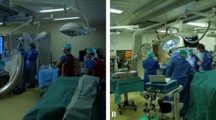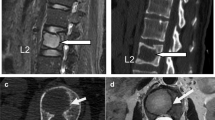Abstract
Objectives
To evaluate, on a long-term basis, the safety and effectiveness of percutaneous alcohol embolization (PAE) combined with percutaneous vertebroplasty (PVP) as a sole treatment for aggressive vertebral haemangiomas (AVHs) with epidural extension.
Methods
From 1996 to 2015, 26 consecutive patients (15 women [58%] and 11 men; mean age 51.8 years [range: 19–75 years]) underwent PAE combined with PVP (performed at day 15) for the treatment of 27 AVHs with epidural extension. Clinical outcome was evaluated with a mean delay of 88.3 ± 53.3 months (range: 22–217 months). The primary endpoint was pain relief evaluated with a visual analogue scale (VAS).
Results
Pre-procedure mean VAS score was 7.23 ± 1.3 and significantly improved at last follow-up (m = 3.11 ± 1.9; p < 0.001). Ten patients (38.5%) remained asymptomatic. Eighty-eight percent of the patients with neurosensory disorders had complete regression of these symptoms. Two of the three patients with motor deficit did not show any improvement. No major complication was recorded.
Conclusions
PAE combined with PVP is a minimally invasive safe and effective therapeutic approach for AVH with epidural involvement, even on long-term clinical outcome. This technique appears mainly effective for pain and neurosensory symptoms, but seems less effective for motor deficit relief.
Key points
• Combination of PAE with PVP is a safe technique.
• PAE combined with PVP is an effective treatment for sensory symptoms.
• This strategy seems less effective in patients with motor deficits.



Similar content being viewed by others
Abbreviations
- AVH:
-
Aggressive vertebral haemangioma
- CT:
-
Computed tomography
- DSA:
-
Digital subtraction angiography
- MRC:
-
Medical Research Council
- MRI:
-
Magnetic resonance imaging
- PAE:
-
Percutaneous alcohol embolization
- PMMA:
-
Poly-methyl-methacrylate
- PVP:
-
Percutaneous vertebroplasty
- VAS:
-
Visual analogue scale
- VH:
-
Vertebral haemangioma
References
Schmorl J (1960) The human spine in health and disease. New York and London: Grune and Stratton. Br J Surg 47:694
Lowe LH, Marchant TC, Rivard DC, Scherbel AJ (2012) Vascular malformations: classification and terminology the radiologist needs to know. Semin Roentgenol 47:106–117
Doppman JL, Oldfield EH, Heiss JD (2000) Symptomatic vertebral hemangiomas: treatment by means of direct intralesional injection of ethanol. Radiology 214(2):341–348
Laredo JD, Reizine D, Bard M, Merland JJ (1986) Vertebral hemangiomas: radiologic evaluation. Radiology 161:183–189
Laredo JD, Assouline E, Gelbert F et al (1990) Vertebral hemangiomas: fat content as a sign of aggressiveness. Radiology 177:467–472
Fox MW, Onofrio BM (1993) The natural history and management of symptomatic and asymptomatic vertebral hemangiomas. J Neurosurg 78:36–45
Jiang L, Liu XG, Yuan HS et al (2014) Diagnosis and treatment of vertebral hemangiomas with neurologic deficit: a report of 29 cases and literature review. Spine J Off J North Am Spine Soc 14:944–954
Goldstein CL, Varga PP, Gokaslan ZL et al (2015) Spinal hemangiomas: results of surgical management for local recurrence and mortality in a multicenter study. Spine 40:656–664
Paternostro-Sluga T, Grim-Stieger M, Posch M et al (2008) Reliability and validity of the Medical Research Council (MRC) scale and a modified scale for testing muscle strength in patients with radial palsy. J Rehabil Med 40:665–671
Peraud A, Drake JM, Armstrong D et al (2004) Fatal ethibloc embolization of vertebrobasilar system following percutaneous injection into aneurysmal bone cyst of the second cervical vertebra. AJNR Am J Neuroradiol 25:1116–1120
Liu X-W, Jin P, Wang L-J et al (2013) Vertebroplasty in the treatment of symptomatic vertebral haemangiomas without neurological deficit. Eur Radiol 23:2575–2581
Pastushyn AI, Slin’ko EI, Mirzoyeva GM (1998) Vertebral hemangiomas: diagnosis, management, natural history and clinicopathological correlates in 86 patients. Surg Neurol 50:535–547
Templin CR, Stambough JB, Stambough JL (2004) Acute spinal cord compression caused by vertebral hemangioma. Spine J Off J North Am Spine Soc 4:595–600
Smith TP, Koci T, Mehringer CM et al (1993) Transarterial embolization of vertebral hemangioma. J Vasc Interv Radiol JVIR 4:681–685
Guedea F, Majó J, Guardia E et al (1994) The role of radiation therapy in vertebral hemangiomas without neurological signs. Int Orthop 18:77–79
Cianfoni A, Massari F, Dani G et al (2014) Percutaneous ethanol embolization and cement augmentation of aggressive vertebral hemangiomas at two adjacent vertebral levels. J Neuroradiol J Neuroradiol 41:269–274
Chen L, Zhang C, Tang T (2007) Cement vertebroplasty combined with ethanol injection in the treatment of vertebral hemangioma. Chin Med J (Engl) 120:1136–1139
Niemeyer T, McClellan J, Webb J et al (1999) Brown-Sequard syndrome after management of vertebral hemangioma with intralesional alcohol. A case report. Spine 24:1845–1847
Galibert P, Deramond H, Rosat P, Le Gars D (1987) Preliminary note on the treatment of vertebral angioma by percutaneous acrylic vertebroplasty. Neurochirurgie 33:166–168
Clarençon F, Fahed R, Gabrieli J et al (2016) Safety and Clinical Effectiveness of Percutaneous Vertebroplasty in the Elderly (≥80 years). Eur Radiol 26:2352–2358
Bonnard E, Foti P, Kastler A, Amoretti N (2016) Percutaneous vertebroplasty under local anaesthesia: feasibility regarding patients’ experience. Eur Radiol. doi:10.1007/s00330-016-4521-1
Guarnieri G, Ambrosanio G, Vassallo P et al (2009) Vertebroplasty as treatment of aggressive and symptomatic vertebral hemangiomas: up to 4 years of follow-up. Neuroradiology 51:471–476
Boschi V, Pogorelić Z, Gulan G et al (2011) Management of cement vertebroplasty in the treatment of vertebral hemangioma. Scand J Surg SJS Off Organ Finn Surg Soc Scand Surg Soc 100:120–124
Ryu KS, Park CK, Kim MC, Kang JK (2002) Dose-dependent epidural leakage of polymethylmethacrylate after percutaneous vertebroplasty in patients with osteoporotic vertebral compression fractures. J Neurosurg 96:56–61
Acknowledgements
The scientific guarantor of this publication is Jacques Chiras. The authors of this manuscript declare no relationships with any companies whose products or services may be related to the subject matter of the article. The authors state that this work has not received any funding. No complex statistical methods were necessary for this paper. Neither approval from the institutional review board nor patient informed consent are required by the ethics committee of our institution for retrospective analyses of patients’ records and imaging data. Methodology: retrospective, observational, performed at one institution.
Author information
Authors and Affiliations
Corresponding author
Rights and permissions
About this article
Cite this article
Premat, K., Clarençon, F., Cormier, É. et al. Long-term outcome of percutaneous alcohol embolization combined with percutaneous vertebroplasty in aggressive vertebral hemangiomas with epidural extension. Eur Radiol 27, 2860–2867 (2017). https://doi.org/10.1007/s00330-016-4664-0
Received:
Revised:
Accepted:
Published:
Issue Date:
DOI: https://doi.org/10.1007/s00330-016-4664-0




